- Home
- Courses
- Cinema Exhibition Training
- Training for Non-Technical Cinema Employees
Curriculum
- 7 Sections
- 47 Lessons
- Lifetime
- Artistic Intent – Why We Are HereThe Producers and Directors all believe that if they make their vision come to life – make their story into a movie – it will be shown in a way that allows the audience see and hear what they created with the same splendor they realized. Were they wrong?2
- Quality Management BasicsIf something is managed properly, then there is control over the quality of the items being delivered, and assurance that the end user will be satisfied. Quality Management | Quality Control | Quality Assurance12
- 2.1Ideas Behind The Checklist
- 2.2Security and You
- 2.3Training and You – and the ISO 9001 Management System – Part 1
- 2.4Routines to Self-Certify – Checklists and Employee Training – Part I
- 2.5Routines to Self-Certify – Checklists and Employee Training – Part II
- 2.6How to: Manager’s Walk Through
- 2.7How to: Manager’s Walk Through – Part 2
- 2.8Units of Measurement25 Minutes
- 2.9Where to Judge The Auditorium
- 2.10Forensics, Encryption, KDM, CMS, FLM and 3 Letter Acronyms
- 2.11Alternative Content = Non-Cinema Tech
- 2.12Units of Measurement – Part 2
- Cinema Basics – AudioSome say that a movies sound is 50% of the movie. So, it better be good, eh?7
- Cinema Basics – PictureSound has nuance. Picture has a thousand words for nuance. Let's learn some.7
- Making MeasurementsYour picture and sound equipment get calibrated according to a schedule that management thinks is appropriate for your facility – sometimes in 6 month or 12 month or 18 month intervals. But we all know that things happen in between. With the right tools, you can become the judge.4
- Accessibility EquipmentSome of our customers use the large speaker systems to know what the actors are saying, some read the words with special "closed caption" equipment...some listen to special tracks on headphones. The equipment is called Accessibility Equipment. We have to understand it and test it to make certain our customer gets the best experience possible.14
- 6.1The Other-Abled, and You
- 6.2Accessibility To Inclusion In Cinema – Prelude
- 6.3Promise, Promises and Great Expectations
- 6.4The Access Community
- 6.5Accommodation, In General
- 6.6Accommodation, Open Captions
- 6.7Accommodation, Closed Captions
- 6.8No Technology Before Its Time
- 6.9Industry Coordination
- 6.10Different Paths; …and Finally, Results
- 6.11DCP Production – Narration and Closed Caption Creation
- 6.12Currently Available – “Personal” Closed Caption Solutions
- 6.13Specialized Audio Systems for the Blind and Partially Sighted
- 6.14Signing In Cinema
- EmergenciesLife happens in real time. Sometimes we read about it. More rarely, we are there. And after, we wish that we could have practiced a little bit before being thrown into it.1
What Does It Mean: Scope and Flat?
The first question: Why Do We Care?
Every Answer begins the same way: There are many things that can go wrong with the presentation of the moving picture and its sound.
In this case, we are working with the shape of the picture. Movies evolved from almost square to very wide. Now, there are two systems in use. The equipment rarely fails, the instructions the equipment receives is rarely wrong. But it can, in many ways.
This topic is a little tricky. Even if the shape is wrong – too narrow or too short – at least the image is on the screen. In some cases, the images may look OK if you just glance at the image. But there are things to look for.
Will the audience care? Many will. They will think that the screen looks too small, or the image looks too small. (Nobody ever complains about too big!) They may complain that the people on screen are too thin, or too fat.
Buzzwords: “Scope” “Flat” “Format” “Constant Height” “Constant Width” “Aspect Ratio” “Two-Three-Five” “One-Eight-Five” (written “2.39” or “1.85” and “2.39:1” or “1.85:1”), and grey bars.
We will show the definition of these terms with examples. Don’t look them up now – they have too many meanings and most explanations are more complicated than we need to be.
The Complication: There are 2 basic forms for an image on the screen. Some auditoriums will choose one shape to start with, then modify that shape to make the other shape fit. Some auditoriums will have the other. Even in the same facility, some auditoriums may be one type, and other auditoriums may be the other type! It is a small complication, in fact. But if it isn’t dealt with correctly, then the presentation will be just odd enough, just far enough from OK, to be a problem that needs solving.
Oh…and there is something called “Masking” that can be moved in or out, and up or down, to change the way that the screen appears, surrounding the screen with dark, light absorbing material. It is connected to motors and chains which sometime just get stuck.
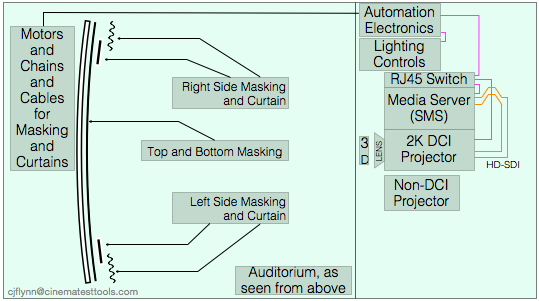
Potential Points of Failure: Screen. Curtains. Motors for Curtains. Cord for Curtains. Masking. Motors for masking. Chains for masking. Automation Electronics for the masking and the lens of the projector. The Projector itself! Automation setting on Playlist. Instructions that tell which setting to put into the playlist!
Don’t let this get too complicated. We are only talking about the size of the rectangle of the movie on the screen.
Movies are created in 2 different shapes. The measurements for both of them is just about 2 times as large side to side (the width) compared to the dimension from top to bottom (the height). For example, the following picture shows this concept of a rectangle that is 2 times wide and 1 times high.
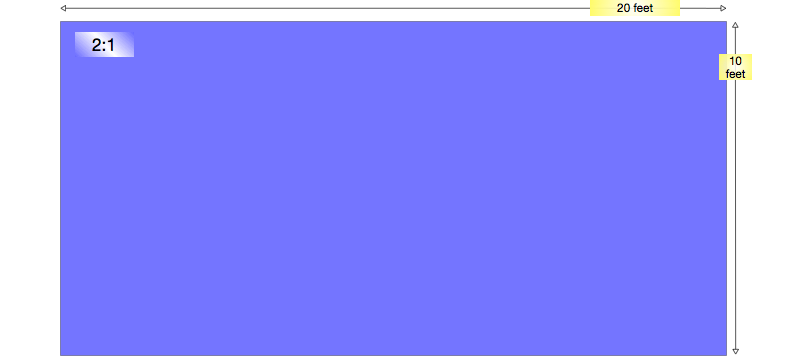
A simple way to write this is ‘2 to 1’ or ‘2:1’, which means 2 units in one direction compared to 1 unit in another direction.
The important things to remember are:
There are two formats
One format is slightly smaller than 2 times wide and 1 times tall – that format is called Flat.
One format is slightly wider than 2 times wide and 1 times tall – that format is called Scope.
Here is a picture of those 2 formats placed with our 2 to 1 picture. You will notice that the light blue “Flat” picture is smaller than the purple 2 to 1 ratio, and the pink “Scope” picture is larger than the 2 to 1 ratio.
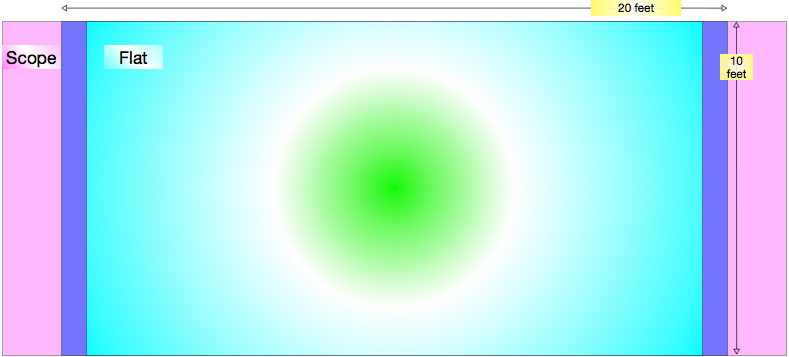
The choice for this happens very early in the movie making process – probably during the first hours of conversation between the producer and director and the Director of Photography – the DP, who is also known as the cinematographer. Will we shoot this movie wide or do we shoot this movie tall?
Of course, they don’t use those terms. Art and Science are never that simple – there are always special words, or words with special meanings. They choose between “Scope” or “Flat”.
Here is a fun video that shows why the DP of a movie might make one choice or the other. What they do in the production of the movie becomes what we do in exhibition.
There is no rule that says a movie should be one way or the other. Sometimes a director will only work in one form, then suprise you by making a movie in another. Or, sometimes people will say that all action movies are in Scope. But a little research will show that isn’t always true.
Anyway, after the director’s decision, every scene of that movie will be shot through a lens that is in that form – what is called a format. And of course, the last lens of the movie process – the lens that is attached to your projector – will make the movie appear in that format on your screen.
 Maybe you remember those old maps with the ship at the edge near the sign that says: Warning – Here Be Dragons~! Well…Warning — Here Be Maths~! …and, yes, we promised to keep math to a minimum. But there will be drawings too, with arrows and bright colors. So, be brave.
Maybe you remember those old maps with the ship at the edge near the sign that says: Warning – Here Be Dragons~! Well…Warning — Here Be Maths~! …and, yes, we promised to keep math to a minimum. But there will be drawings too, with arrows and bright colors. So, be brave.
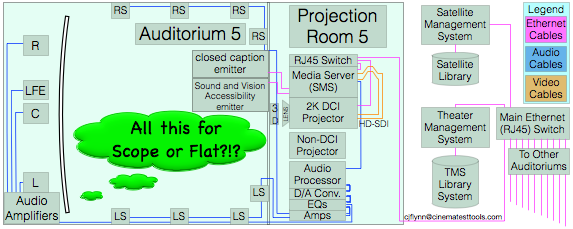 Like many of these lessons, this information is useless until there is a problem. Then the boring background information becomes very important. Some of your audience may notice and complain …or maybe they don’t complain. They just feel uncomfortable for some reason – they never come back. But you’re a pro, so let’s go.
Like many of these lessons, this information is useless until there is a problem. Then the boring background information becomes very important. Some of your audience may notice and complain …or maybe they don’t complain. They just feel uncomfortable for some reason – they never come back. But you’re a pro, so let’s go.
The background of the issue is that some directors and producers feel that their movie needs to be wide and expansive – big desert scenes and lots of characters spread out wide…or single lonely characters shown against the hugeness of their environment. But the director might feel that their movie should be close and snug – a focus on a character in a character-driven story.
In the auditorium, the subject of screen size is different than the subject of the size of the movie. The actual size of the screen is a choice between the cinema owner and the architect. They have to decide how wide the auditoriums are going to be. They know that the movies are going to be in Flat or Scope, but they need to compromise. They either decide to install a wide screen that is perfect size for Scope, or a tall screen that is a perfect size for Flat.
Here are some examples with pictures that show this.
Example 1: Imagine that they have a big tall space for a screen. A big Flat sized screen fills up the front wall.
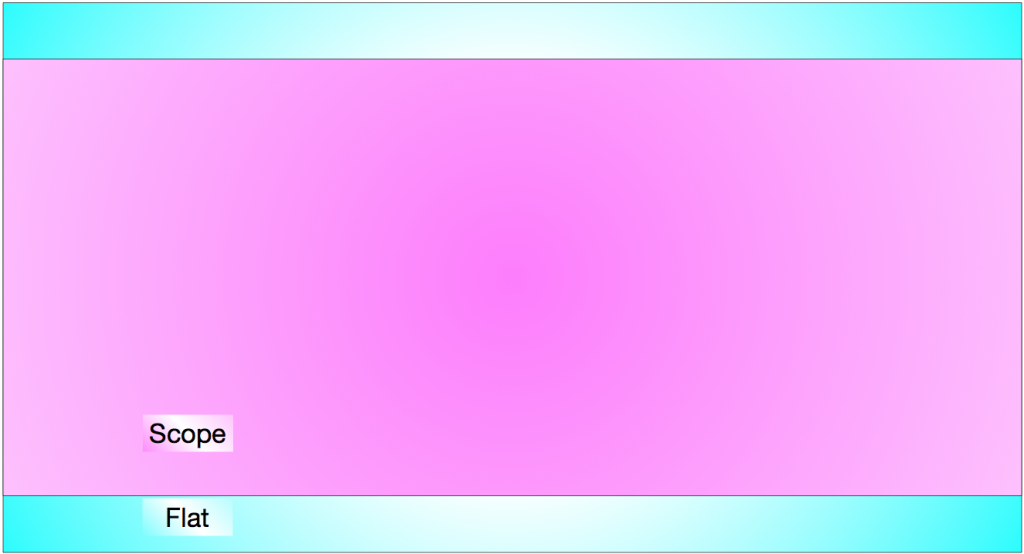
Cool; a Scope picture will fit into that very nicely. Since they are the same width, we call this a Constant Width Screen. In this example, we have light blue and purple colors to show the 2 different screens, but of course, they are both really white. So, if a Scope movie is playing on this screen, there are 2 white bars on top and bottom, or, there will be masking that comes down from above the screen to cover a wider bar from the top.
Example 2: The next example is the opposite. The designer of the auditorium doesn’t have the space for a tall screen. But they have the front wall space for a wide screen. For comparison, these two example pictures are the same height. The Scope size doesn’t suffer, but the Flat size does.
Sometimes this is called Constant Height, and you can see why. The Flat movie has to shrink down to fit onto the Scope screen so they are the same height. In this case, if a Flat movie is playing on this screen, there are 2 choices: two white bars on either side of the screen, or black masking can be moved in during the Flat movie.
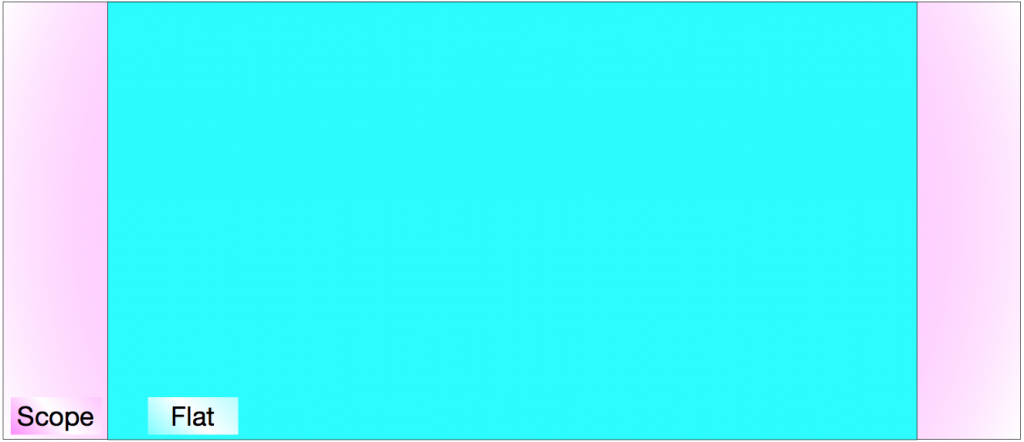
Example 3: The next example is also very common. In a smaller room, sadly, there isn’t enough space for a big tall screen, and there isn’t space for a wide screen.
So, again, we have Constant Width. The Flat screen gets the same width as the Scope screen. 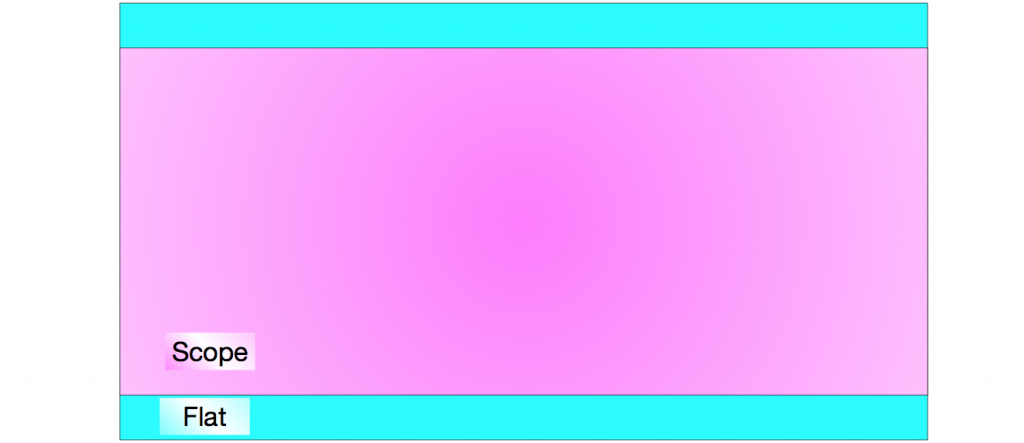
The question they have is: Do we begin with a Flat dimensions, which show the Flat movies perfectly but present Scope movies smaller – and with bars on the top and bottom? Or, do we start with the Scope dimensions, which show the Scope movies perfectly but show the Flat movies too small top to bottom, and with bars (or masking) on the sides?
First, a short talk about projectors. They project light, right? And light is white. So, what we said above is true; when the picture is in the center of the screen and there are bars on top and bottom or bars on the sides, the picture will be surrounded by white. Except, that doesn’t happen. Someone, an editor or some post production specialist will actually put black bars in the right places so that there is no white light blinding us in the dark theater.
But, the thing about projectors is that they don’t produce perfect black. And the thing about auditoriums is that they reflect light back onto the screen. So do people’s clothes and faces, and the empty seats. These reflections get added to the not-perfect greyish-black from the projector to make an even lighter shade of grey.
What is wrong with grey instead of black? This is covered in the Lesson on Contrast so we won’t go into detail here. Simply stated, a picture will look sharper, colors more vibrant, if they are surrounded by a black background instead of a white background. Grey is black with white added. Maybe yellow-white if the auditorium has a lot of gold reflecting on the screen. Maybe green-grey if everyone in the audience is where green jackets. Anyway, it will make the picture look ‘wrong’, which is why masking is made from absorbing black clothe. It makes a better image. It will eat up bad edges from the projector. It will eat up reflections from the room. OK? Back to Scope and Flat.
Let’s imagine a perfect world where there are two different sized screens in two different sized auditoriums.
First, the Scope screen which is 2048 units wide by 858 units tall. You see the Star Wars movies and many big action movies in this format…but not all. Sometimes the director wants something different.
In the 2nd room there is a Flat screen which is almost the same width – 1998 units – but it is 222 units taller. 222 units is about 25% taller than the Scope size of 858 units. In numbers it may not seems like a lot. But imagine that your arm was 25% longer. Yeah…Avatar long hands and arms.
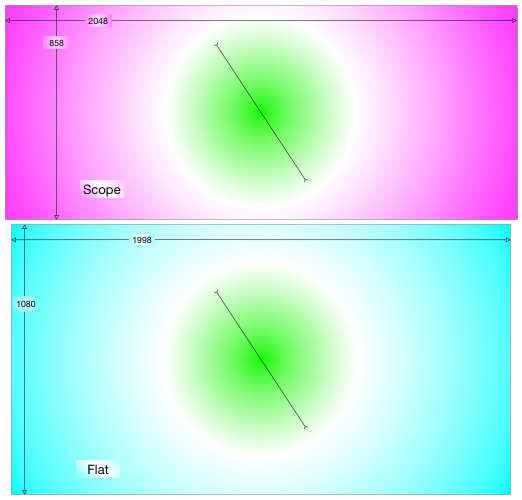 Here it is in pictures. But what is this dimension made of? Inches? Meters? Centimeters? It is very unlikely that you will measure 2048 inches or centimeters or feet or meters across. Yet, 2048 is a basic size of digital cinema.
Here it is in pictures. But what is this dimension made of? Inches? Meters? Centimeters? It is very unlikely that you will measure 2048 inches or centimeters or feet or meters across. Yet, 2048 is a basic size of digital cinema.
1-2-4-8-16-32-64-128-256-512-1024-2048-4096
To learn this simple trick, we have to get very close to the screen when it is playing a test pattern. You will see the screen and tiny holes where the sound comes through. Then magically, it will become obvious – especially if you look at a grey or white patch – that there is a set of blue and red and green dots almost on top of each other. A very small distance from that set is another set of the same and another and another. These groups are the basic elements of the picture. Instead of saying “picture elements” all the time, we mix the words together and say ‘pixels’. The Scope picture is 2048 pixels wide and the Flat is 1998 pixels wide.
For comparison, the same is true if you look at a TV screen or computer monitor. Computer monitors don’t have a standard width. But the HDTV standard width is 1920 pixels. Recently though, the stores are selling 4K TVs. Even if they aren’t always 2 times wider, they do have 2 times the number of pixels…3,840. In the movie theater, the 4K projectors have 4,096 picture elements across.
One last note: Actually, every year, a director will insist on making their movie in odd shapes for one reason or another. There are even movies where the dimensions change from Flat to Scope or the opposite. These exceptions are not detailed in these lessons. And they are not optimum for the cinema exhibition since most projectors (and masking systems) are not set up to handle them, so the picture ends up getting shown in the smaller size. Alas.
There are also proprietary solutions – ‘proprietary’ meaning that they are owned or used by a single company. IMAX is an example of this. They use a size that is derived from the 65 millimeter film that some directors like to use. Very tall compared to wide. You sit up close, so you are immersed in the picture.
Dolby is another example of proprietary solutions. They have developed a projector that creates and projects blacks that are so black that masking isn’t needed. They can have screens that go from floor to ceiling, and wall to wall.
That is it for now. You have a lot to review here. Take some time. Look at the different auditoriums you walk into and think of why they chose the screen during the design phase. Ask a tech if you can go behind the screen to see the motors and chains that move the masking. Ask the projectionist to show you the relays or ethernet box that sends the signals from the media player to the motor controller. In the auditoriums that don’t have masking, look at the grey bars. In auditoriums with masking, notice how it makes certain that the picture that the audience sees is actually a rectangle with clean edges.
We’ll continue this in Part 2 of What Does It Mean: Scope and Flat?